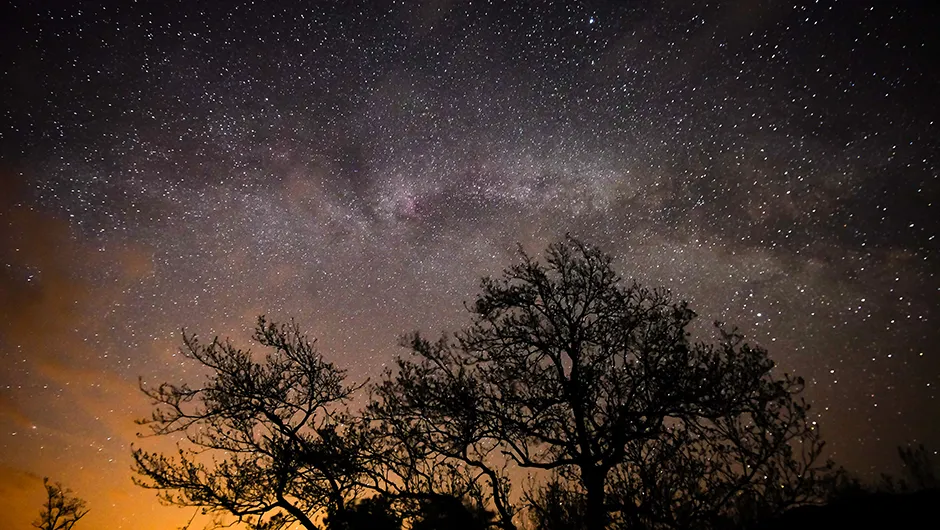Light pollution from towns and cities can be a menace for amateur astronomers. Dark sky sites provide suitable conditions to view a starry night sky. Image Credit: iStock
Night-time light pollution affects nearly 80 per cent of the world.
That was the headline finding from a study published in mid 2016 by the Light Pollution Science and Technology Institute in Italy.
The study also announced that a third of people on Earth can no longer see the glimmering band of the Milky Way.
Clearly, amateur astronomers have a lot to compete with in order to get a decent view of the night sky.
Much work is already being done by concerned bodies to preserve darkness or else achieve it where light pollution looms, resulting in an explosion of sites with ‘certified’ skies – places where you can be sure of a certain level of darkness or sky quality.
You may have come across the terms for some of them, such as ‘Milky Way class’ sites and ‘Dark Sky Reserves’, while searching online.
Many of these designations come from the International Dark Sky Association (IDA), founded in 1988 to support and reward those seeking to improve the quality of the night skies above their homes, towns, cities and even national parks.
It works with councils, communities and legislators globally to reduce the glare of artificial lighting, and much of its work involves the introduction of lighting that is more sympathetic to maintaining natural darkness.
Defining darkness
The IDA’s Dark Sky Places programme designates the darkest regions around the world in six categories:
- International Dark Sky Communities
- International Dark Sky Parks
- International Dark Sky Reserves
- International Dark Sky Sanctuaries
- Urban Night Sky Places
- Dark Sky Friendly Developments of Distinction
These are terms you may have come across, but may still be unsure exactly what they mean.
Towns, cities, municipalities and other populated areas may apply to be recognised as an International Dark Sky Community, provided there exists evidence of “exceptional dedication” to the dark-sky cause.
Typically, such communities are legally incorporated entities, meaning they are free to enforce their own outdoor lighting policy.
This includes islands like Coll in Scotland and Sark in the Channel Islands.
The status of International Dark Sky Park is awarded to areas where the night-sky brightness is regularly equal to or darker than 20 magnitudes per square arcsecond.
The land may be public or private, but there must be public access to the relevant areas.
There is, however, no required minimum land area.
An International Dark Sky Reserve must experience brightness of no more than 20 magnitudes per square arcsecond and must be public or private land of at least 700km2.
It must contain a “core area” that meets the minimum criteria, as well as a “peripheral area” that supports the preservation of the core’s darkness.
Parks and Reserves are further divided into gold, silver and bronze tiers.
Gold means a visual limiting magnitude – in other words, the faintest stars you can see – equal to or greater than +6.8 under clear skies, silver means +6.0 to +6.7 and bronze means +5.0 to +5.9.
Gold calls for a complete lack of lighting on towers or buildings within the area boundary.
An array of phenomena should be visible like aurora, airglow, the Milky Way, zodiacal light and faint meteors.
Silver means the Milky Way must be visible in summer and winter, while “minor to moderate” illumination from artificial skyglow is allowed.
Bronze is awarded to areas that don’t meet the silver standard, but which still maintain visible natural sky.

Filling the void
A Dark Sky Sanctuary is typically an isolated location with few or no threats to the quality of darkness.
The designation was introduced in 2015 to bridge the gap between the Park and Reserve definitions.
Such areas are sometimes inaccessible to the general public due to the fragility of their natural darkness and so cannot be considered a Park, but also lack the core/peripheral areas of Reserves.
The Sanctuary designation is intended to ensure that there is awareness of their delicate nature, but also that the potential damage caused to the area through public awareness is minimised.
To achieve any of these four designations, a site must apply to the IDA, which gives advice on any changes needed and then provides support to make them happen.
Urban Night Sky Places are sites "surrounded by large urban environs whose planning and design actively promote an authentic nighttime experience in the midst of significant artificial light at night," but which would otherwise not be considered for designation within any other category.
There’s also a separate Dark Sky Friendly Development of Distinction award, which recognises small communities and developments that promote sensitive outdoor lighting.
Areas must be nominated by an IDA member and receive support from a community leader and residents.
IDA guidelines say that designations “almost always begin with a small group of individuals who organise to seek formal protection of their nightscape”.
So if you and your fellow amateur astronomers want to protect darkness in your local area, visit the IDA website to find out more.
The best of British: how dark skies are classified domestically
There are nine IDA-designated Dark Sky Places in the UK, spread across England, Scotland and Wales, plus two more in the Republic of Ireland.
There’s also a separate scheme run by the home-grown Dark Sky Discovery partnership.
Led by organisations such as the Royal Observatory Edinburgh, the Royal Astronomical Society and the British Astronomical Association, the DSD partnership recognises over 150 areas as Dark Sky Discovery Sites, where quality views of the night sky persist.
These are divided into two categories: Milky Way class and Orion class sites.
Milky Way class means the Galaxy must be visible to the naked eye, while Orion class requires that all seven stars in the Orion constellation can be seen unaided.
Iain Todd is BBC Sky at Night Magazine’s staff writer
